Our Library
Explore our publications, from research papers and series to educational materials, covering all aspects of conflict transformation and peace promotion.
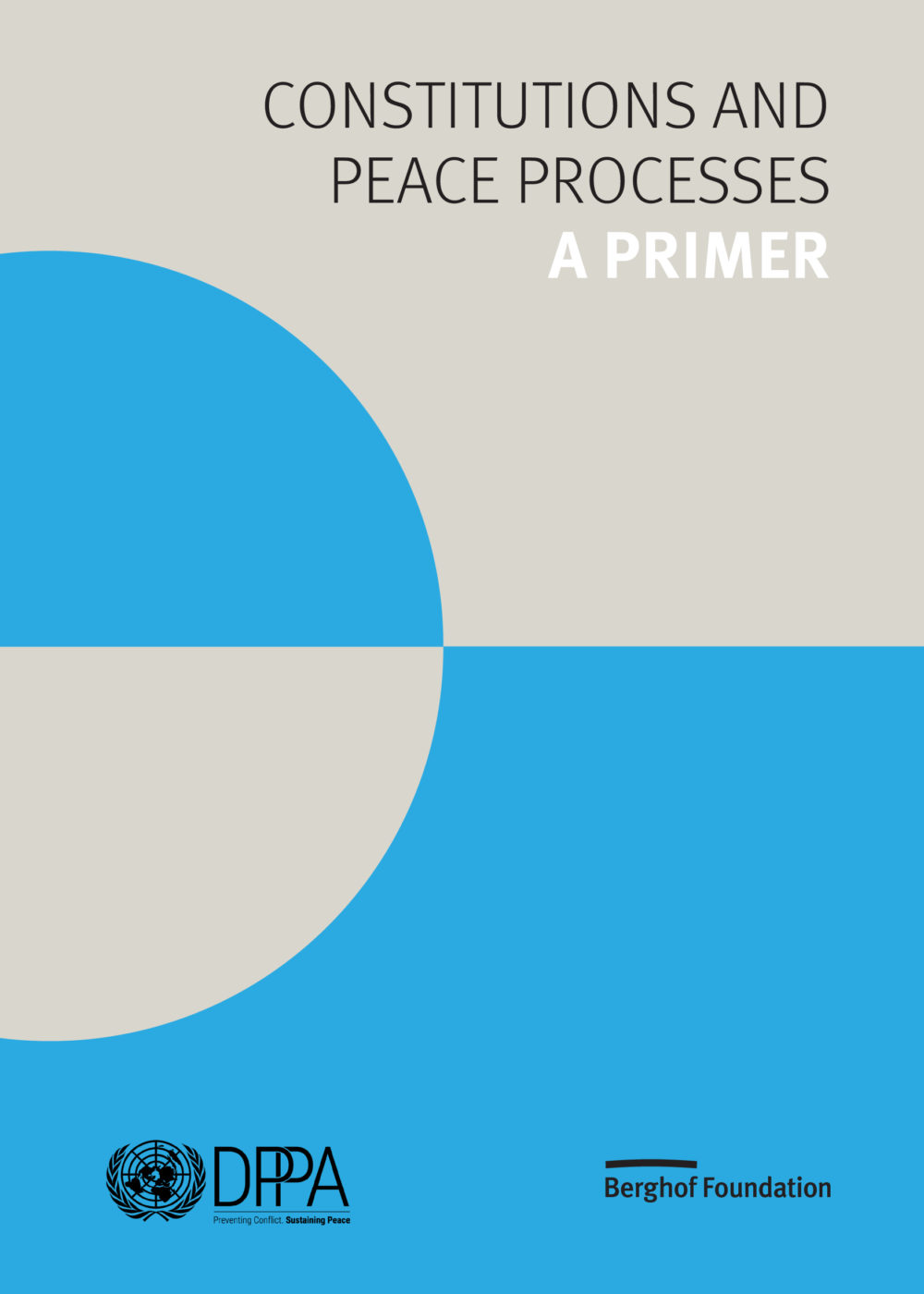
Constitutions and peace processes: A primer
Peace processes often confront conflict issues that have deep constitutional relevance, and yet the obvious link to “constitution making” and the need for constitutional expertise are seldom acknowledged. The role of constitution making in peace processes is understudied and there is little practical guidance for individuals involved in peace processes, especially the mediators, negotiators and other actors who support them, on how to engage with constitutional elements in peace processes.
- Year2021
- Author(s)Berghof Foundation, United Nations DPPA – Mediation Support Unit
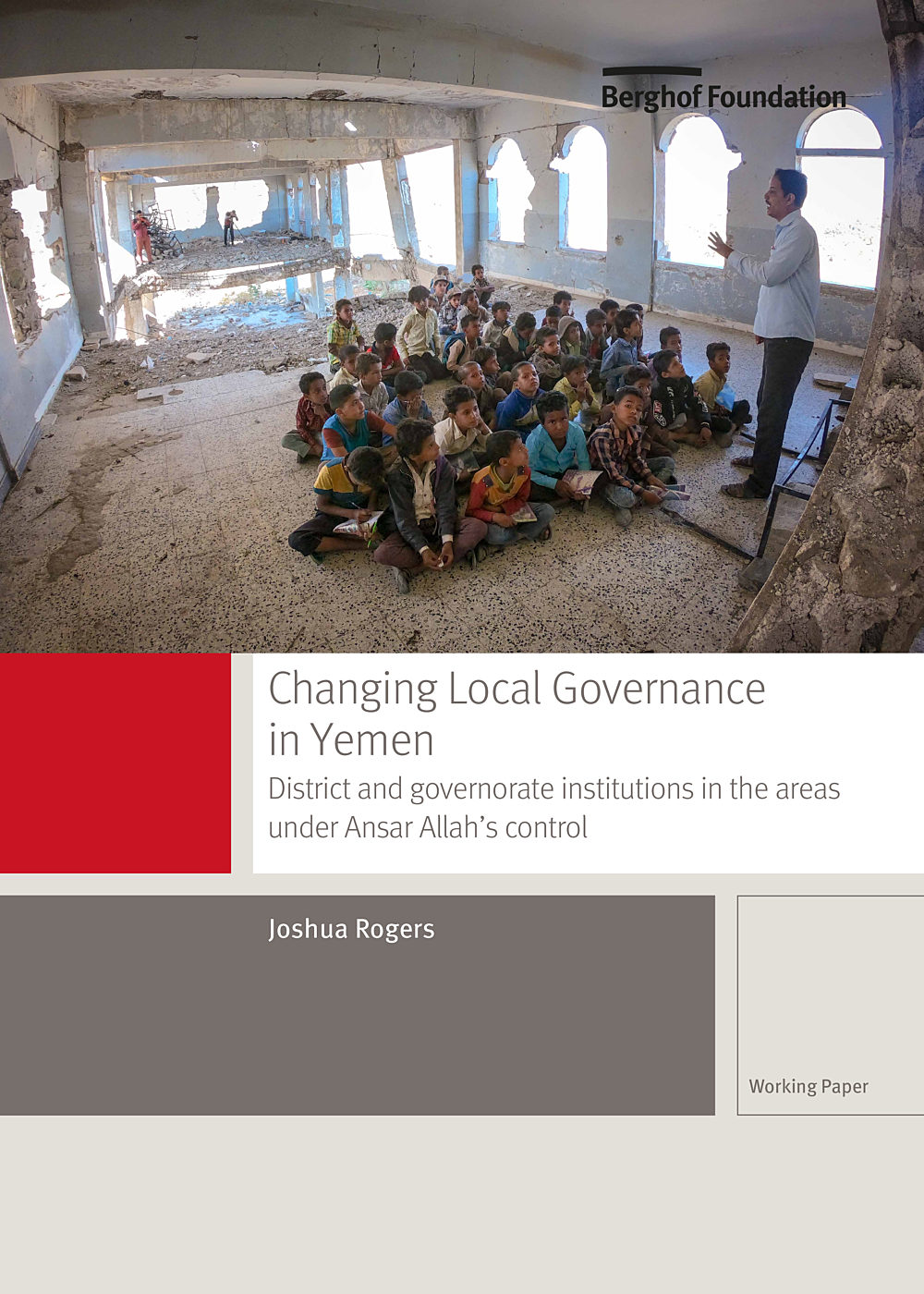
Changing local governance in YemenDistrict and governorate institutions in the areas under Ansar Allah's control
The Berghof Foundation has been working with local authorities and the central administration(s) in Yemen since 2017 to strengthen inclusive local governance, support the resolution of local conflicts, and ensure that key concerns from the local level feed into central policy-making and the peace process. This working paper contributes to these overall goals by exploring how local governance is changing in the areas under Ansar Allah’s control. Subsequent papers will explore local-level changes in other parts of Yemen, notably in Aden and Hadhramawt. The peace process will need to take these ongoing changes into account.
- Year2020
- Author(s)Joshua Rogers
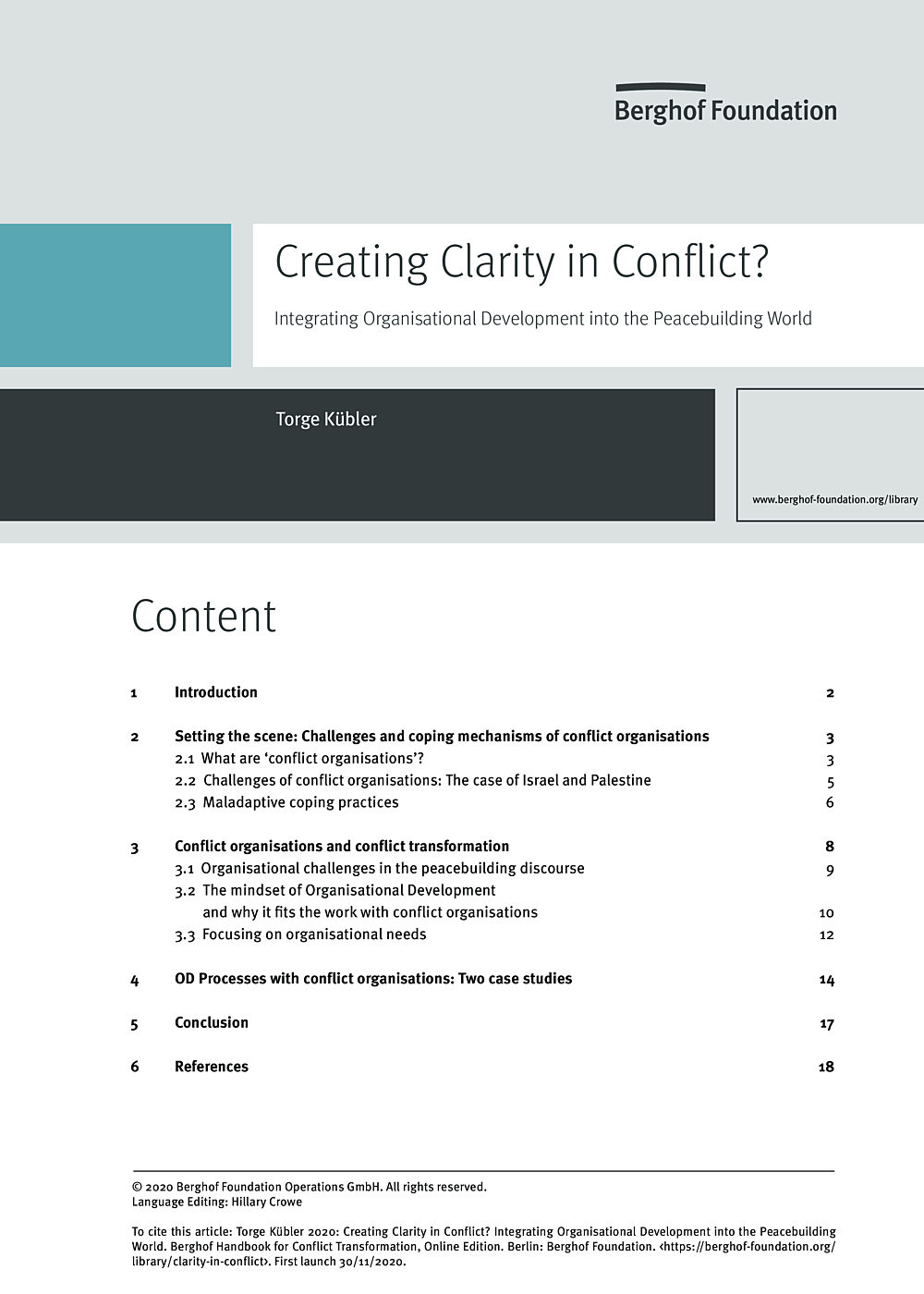
Creating Clarity in Conflict? Integrating Organisational Development into the Peacebuilding WorldHandbook Article
Organisations working in and on conflict face unique challenges that can impact their work and approaches on peacebuilding and conflict transformation. Do we know how to deal with them?
To improve the development of mechanisms and processes that suit the complex nature of peacebuilding endeavors, this article examines how Organisational Development (OD) can contribute to strategies that help to overcome organisational challenges.
- Year2020
- Author(s)Torge Kübler
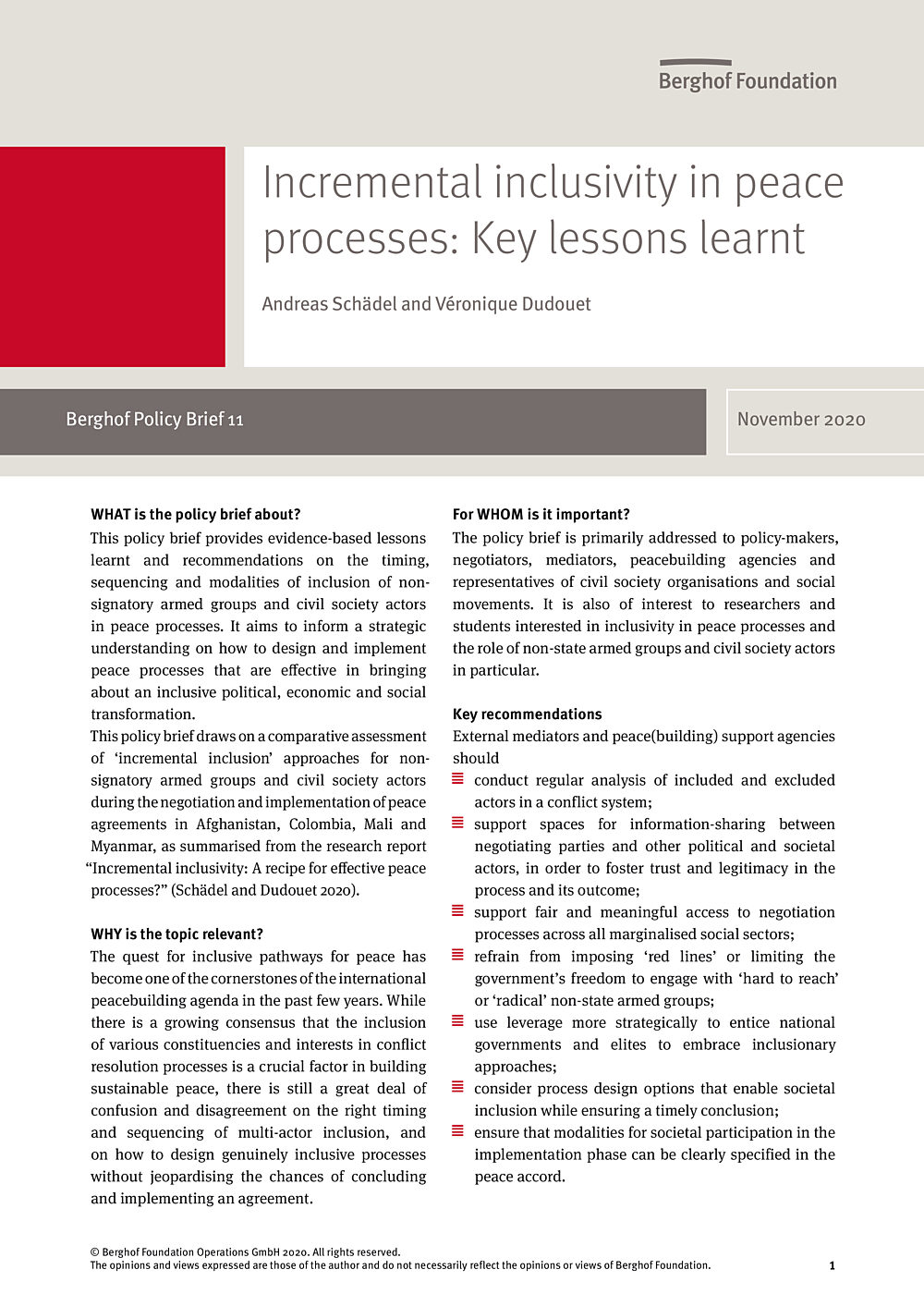
Incremental inclusivity in peace processes: Key lessons learntBerghof Policy Brief 11
This policy brief provides evidence-based lessons learnt and recommendations on the timing, sequencing and modalities of inclusion of nonsignatory armed groups and civil society actors in peace processes. It aims to inform a strategic understanding on how to design and implement peace processes that are effective in bringing about an inclusive political, economic and social transformation.
- Year2020
- Author(s)Andreas Schädel, Véronique Dudouet
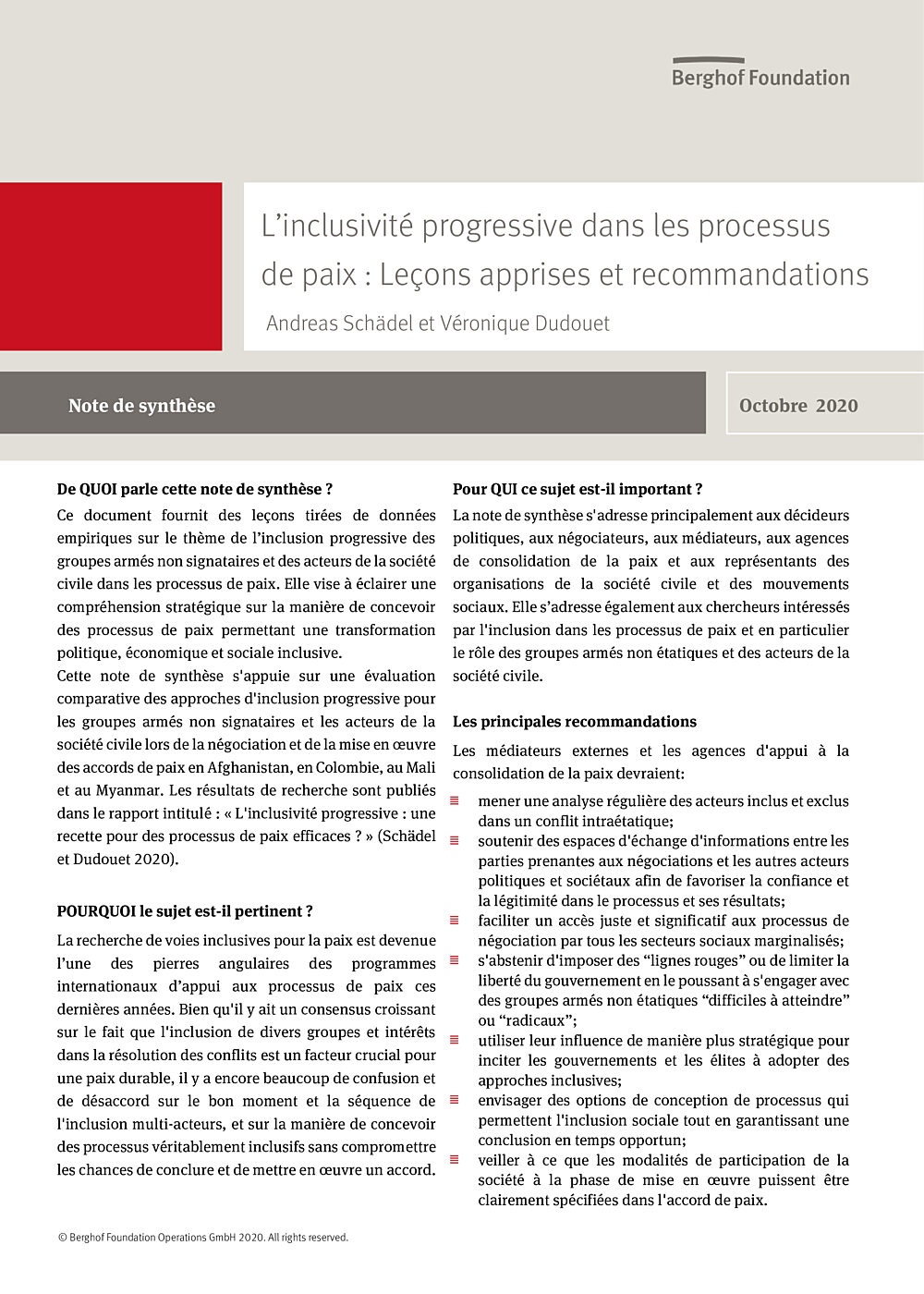
L’inclusivité progressive dans les processus de paix : Leçons apprises et recommandationsBerghof Policy Brief 11
Ce document fournit des leçons tirées de données empiriques sur le thème de l’inclusion progressive des groupes armés non signataires et des acteurs de la société civile dans les processus de paix. Elle vise à éclairer une compréhension stratégique sur la manière de concevoir des processus de paix permettant une transformation politique, économique et sociale inclusive.
- Year2020
- Author(s)Andreas Schädel, Véronique Dudouet
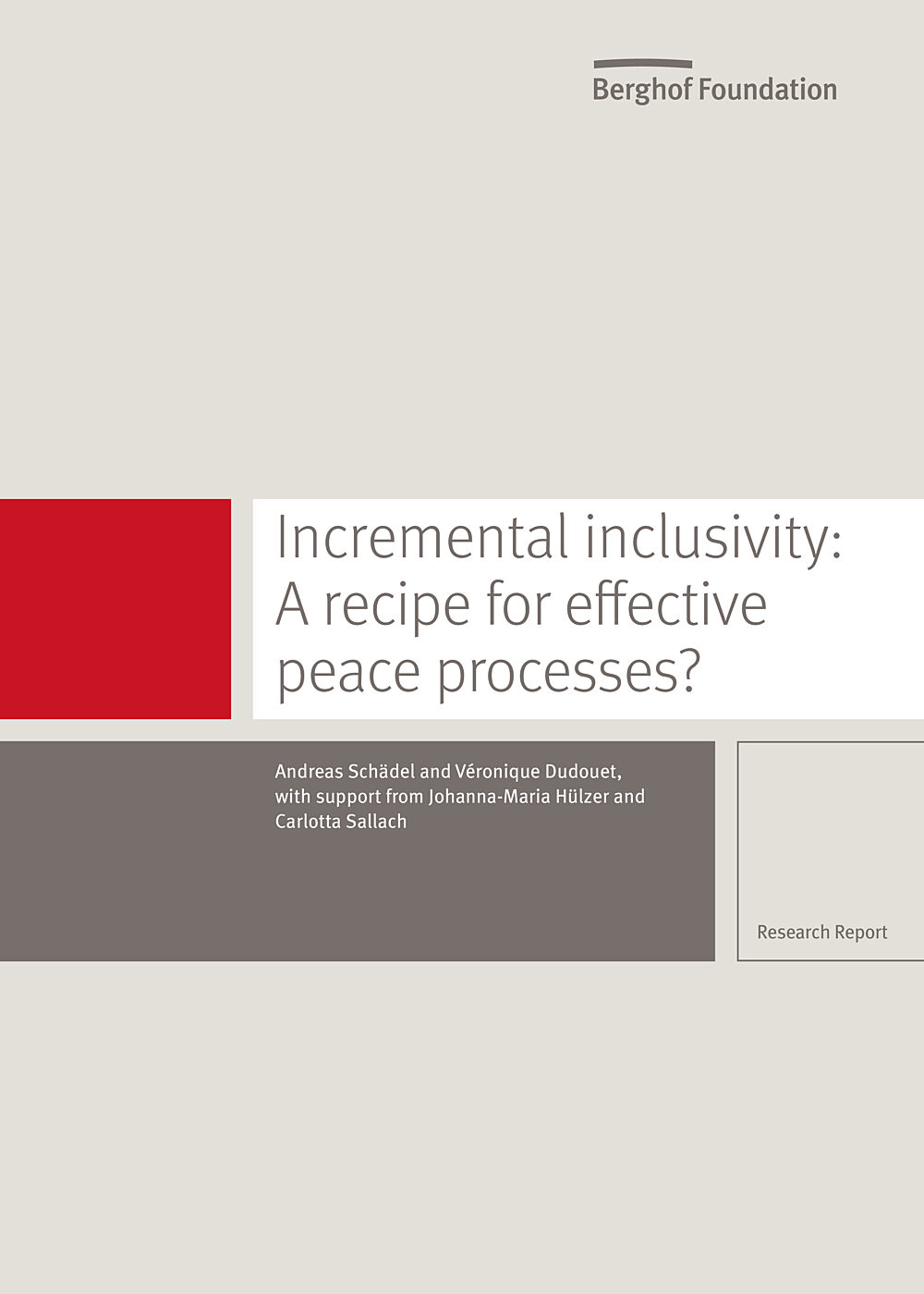
Incremental inclusivity: A recipe for effective peace processes?
The quest for inclusive pathways for peace has become one of the cornerstones of the international peacebuilding agenda in the past few years. While there is a growing consensus that the inclusion of various constituencies and interests in conflict resolution processes is a crucial factor in building sustainable peace, there is still a great deal of confusion and disagreement on the right timing and sequencing of multiactor inclusion in peace process design in order to bring about legitimate, equitable and lasting solutions to complex protracted armed conflicts. This report contributes to this debate by conducting a comparative assessment of ‘incremental inclusion’ approaches for non-signatory armed groups and civil society actors during the negotiation and implementation of four peace/ceasefire agreements.
- Year2020
- Author(s)Andreas Schädel, Véronique Dudouet, Johanna-Maria Hülzer, Carlotta Sallach
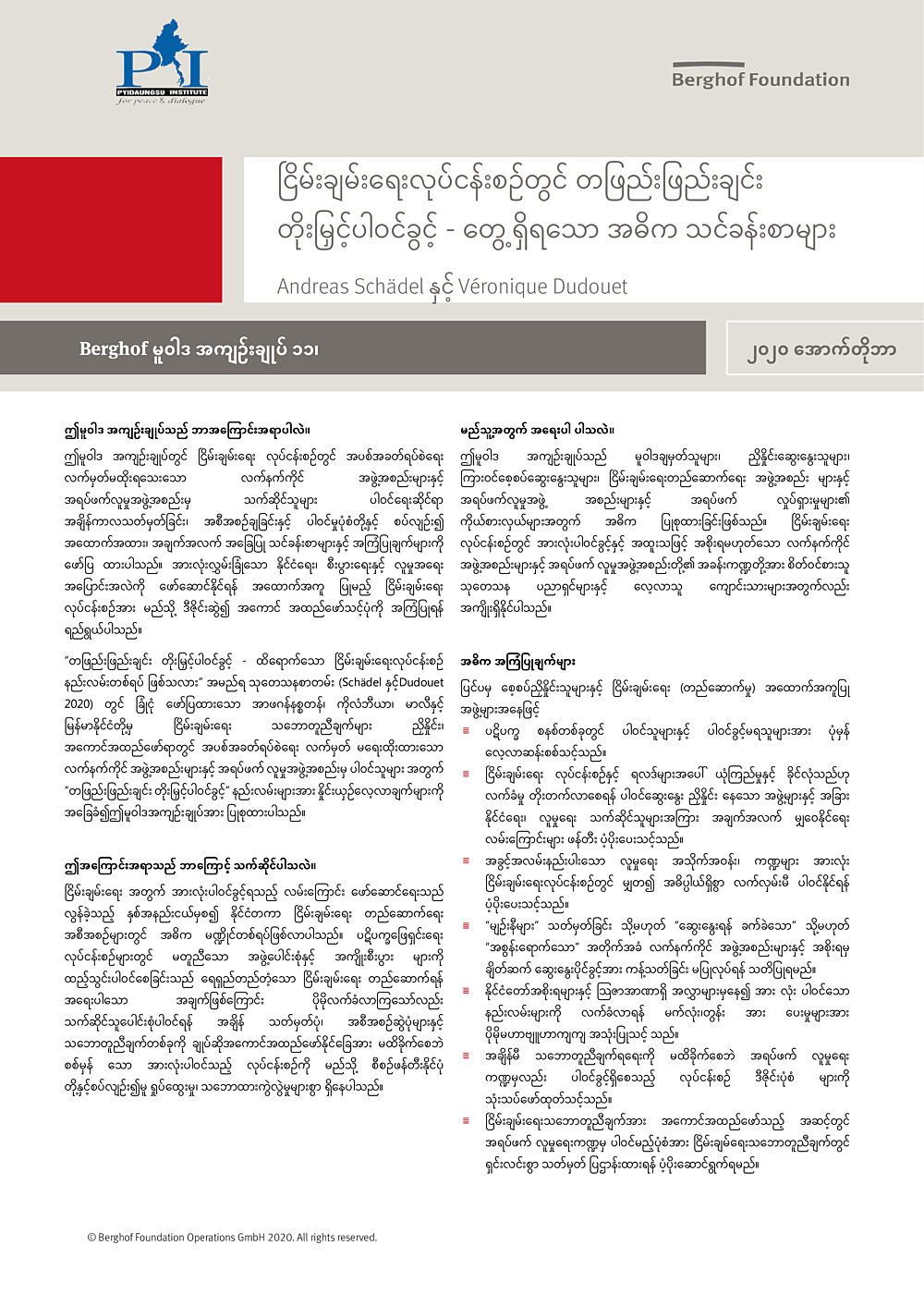
ငြိမ်းချမ်းရေးလုပ်ငန်းစဥ်တွင် တဖြည်းဖြည်းချင်း တိုးမြှင့်ပါဝင်ခွင့် - တွေ့ရှိရသော အဓိက သင်ခန်းစာများBerghof Policy Brief 11
ဤမူဝါဒ အကျဥ်းချုပ်တွင် ငြိမ်းချမ်းရေး လုပ်ငန်းစဥ်တွင် အပစ်အခတ်ရပ်စဲရေး လက်မှတ်မထိုးရသေးသော လက်နက်ကိုင် အဖွဲ့အစည်းများနှင့် အရပ်ဖက်လူမှုအဖွဲ့အစည်းမှ သက်ဆိုင်သူများ ပါဝင်ရေးဆိုင်ရာ အချိန်ကာလသတ်မှတ်ခြင်း၊ အစီအစဥ်ချခြင်းနှင့် ပါဝင်မှုပုံစံတို့နှင့် စပ်လျဥ်း၍ အထောက်အထား၊ အချက်အလက် အခြေပြု သင်ခန်းစာများနှင့် အကြံပြုချက်များကို ဖော်ပြ ထားပါသည်။ အားလုံးလွှမ်းခြုံသော နိုင်ငံရေး၊ စီးပွားရေးနှင့် လူမှုအရေး အပြောင်းအလဲကို ဖော်ဆောင်နိုင်ရန် အထောက်အကူ ပြုမည့် ငြိမ်းချမ်းရေး လုပ်ငန်းစဥ်အား မည်သို့ ဒီဇိုင်းဆွဲ၍ အကောင် အထည်ဖော်သင့်ပုံကို အကြံပြုရန် ရည်ရွယ်ပါသည်။
- Year2020
- Author(s)Andreas Schädel, Véronique Dudouet
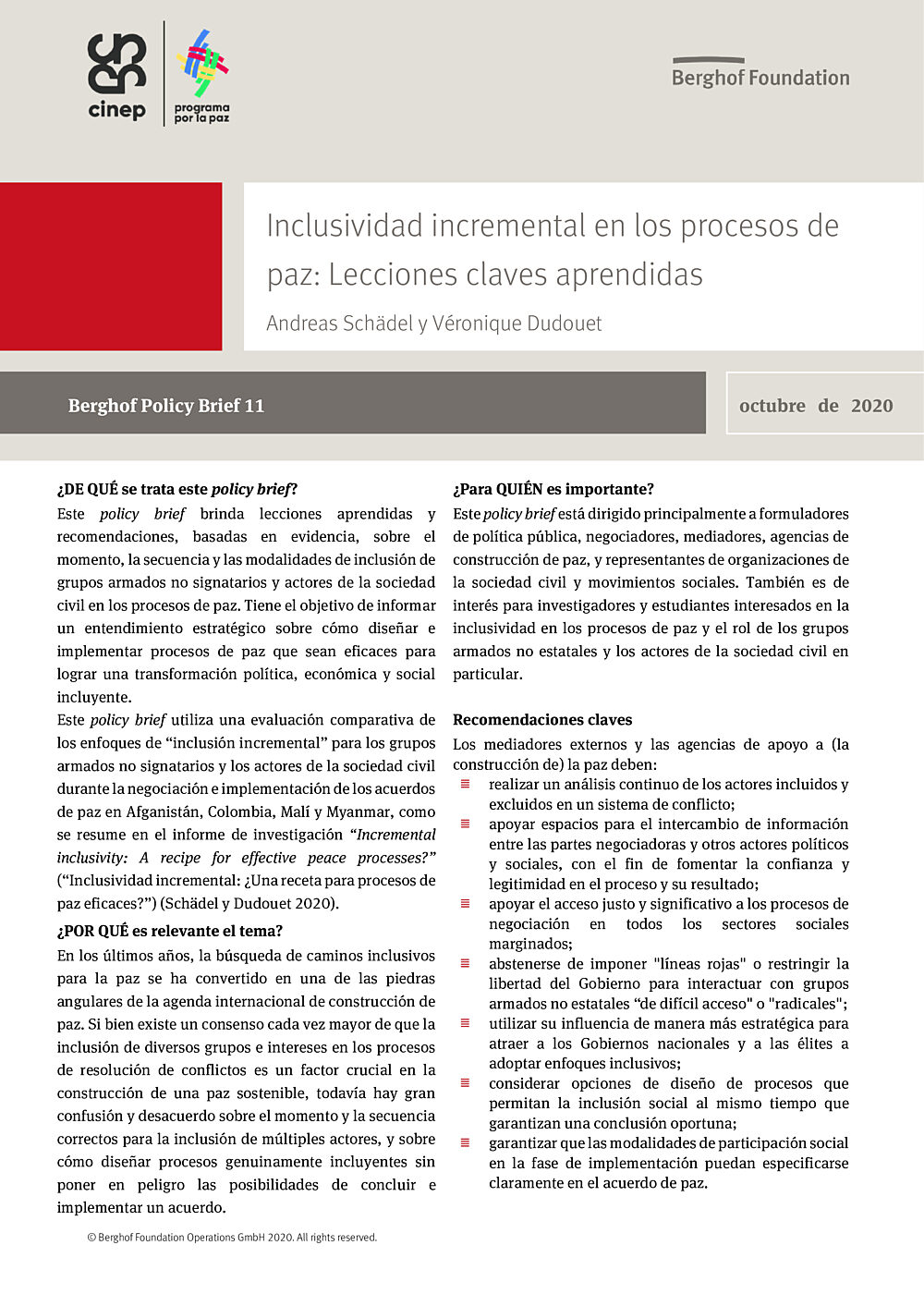
Inclusividad incremental en los procesos de paz: Lecciones claves aprendidasBerghof Policy Brief 11
Este policy brief brinda lecciones aprendidas y recomendaciones, basadas en evidencia, sobre el momento, la secuencia y las modalidades de inclusión de grupos armados no signatarios y actores de la sociedad civil en los procesos de paz. Tiene el objetivo de informar un entendimiento estratégico sobre cómo diseñar e implementar procesos de paz que sean eficaces para lograr una transformación política, económica y social incluyente.
- Year2020
- Author(s)Andreas Schädel, Véronique Dudouet
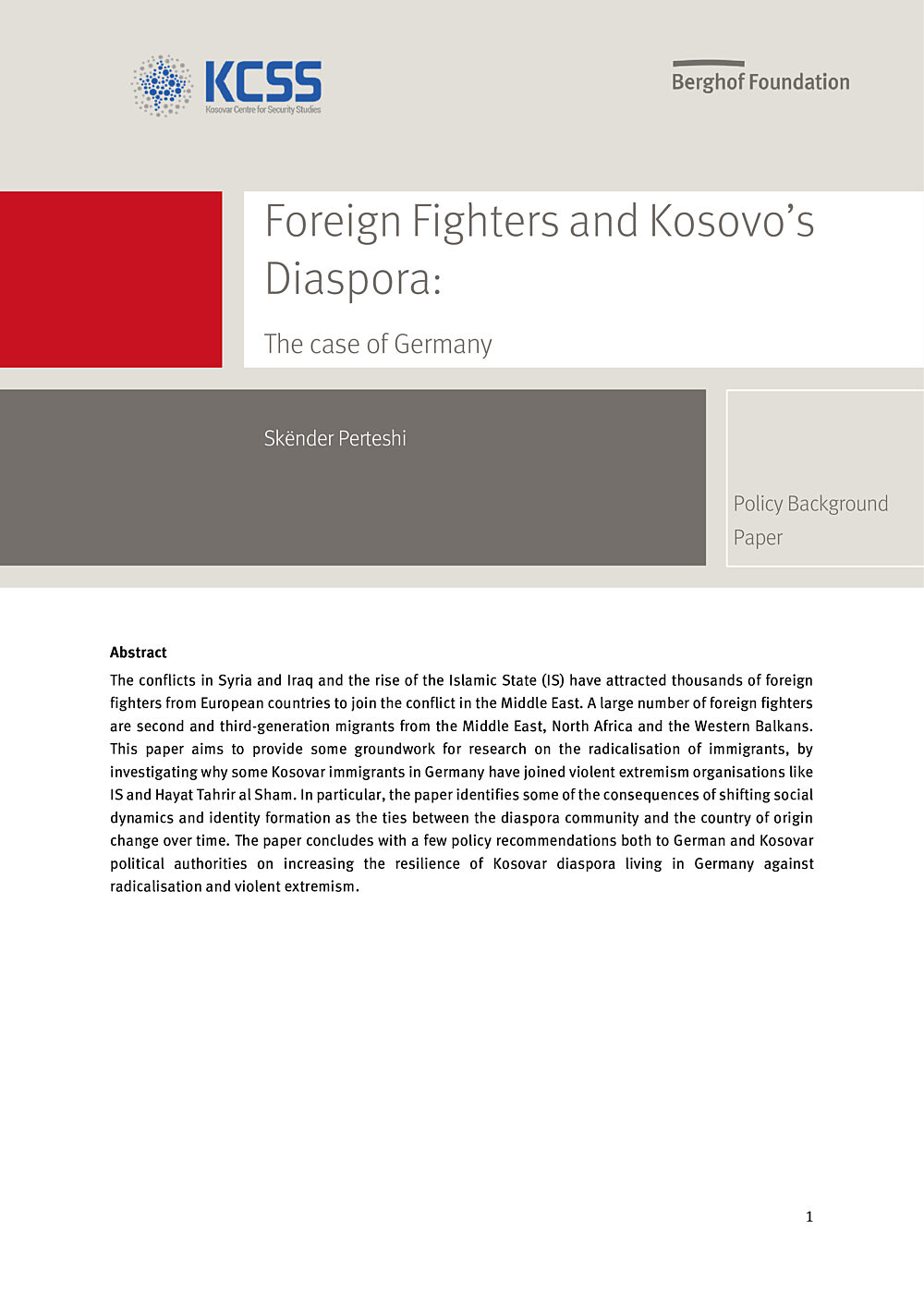
Foreign Fighters and Kosovo’s DiasporaThe case of Germany
The conflicts in Syria and Iraq and the rise of the Islamic State (IS) have attracted thousands of foreign fighters from European countries to join the conflict in the Middle East. A large number of foreign fighters are second and third-generation migrants from the Middle East, North Africa and the Western Balkans. This paper aims to provide some groundwork for research on the radicalisation of immigrants, by investigating why some Kosovar immigrants in Germany have joined violent extremism organisations like IS and Hayat Tahrir al Sham. In particular, the paper identifies some of the consequences of shifting social dynamics and identity formation as the ties between the diaspora community and the country of origin change over time. The paper concludes with a few policy recommendations both to German and Kosovar political authorities on increasing the resilience of Kosovar diaspora living in Germany against radicalisation and violent extremism.
- Year2020
- Author(s)Skënder Perteshi
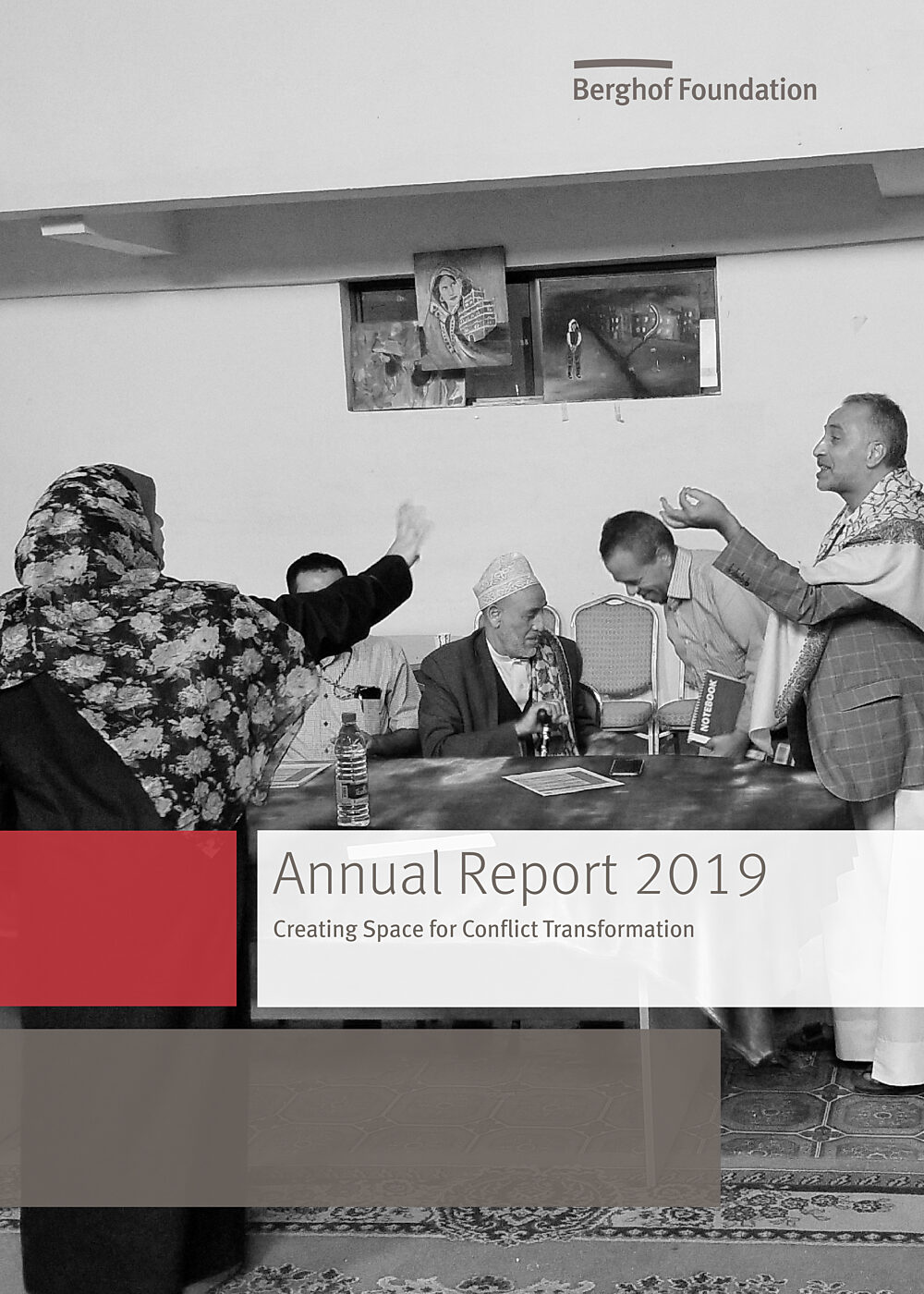
Berghof Foundation Annual Report 2019
In this review of 2019, we want to present a concise picture of our work, using one example from each region to highlight the wide variety of approaches we take to try to transform conflict.
- Year2020